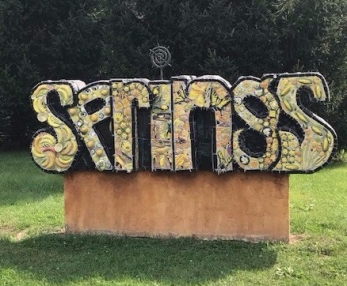
Andrew Kline combined his love of working with his hands, his fascination with environmental sustainability, and his dislike of white-collar desk jobs to found Green Generation Building Co. with his co-owners. I asked Andrew how he crafted his career. The highlights of his story follow.
In the beginning…
Andrew Kline said, “I’ve been one of those people who always likes to work their hands. My parents stopped giving me expensive toys, because I’d take my little toy toolbox hammer, which had a real metal head on it even though it was only two ounces in weight, and I would just beat the heck out of the toy, so I could take it apart and see how it went together”.

Andrew grew up in the Yellow Springs, Ohio area. When he was a teenager, his grandfather, John L. Kline, a local architect, designed a house for Andrew’s family, which Bob Zearfoss, a local contractor, built. “Being interested in construction, I was kind of hovering around the job site and getting in the way and bothering the heck out of them”.
For several years, Andrew was home schooled, which gave him a chance to explore working with his hands. “I worked on a lot of farms, worked with horses, making hay and driving tractors. I explored construction; I worked for contractors. I decided that I really didn’t want anything to do with construction. I’d met a lot of people who weren’t really very happy with their work lives; they were not people I was aspiring to become”. In order to maintain social contact with his peers, Andrew eventually returned to public school and graduated from Greenon High School”.
Did Andrew go to college?
“I was not satisfied with the concept of just immediately entering the work force and not having a greater understanding of the world around me. It felt like I would be closing the door to other experiences and other opportunities”.
Andrew started at Wright State University, and then transferred to Antioch College to major in environmental studies. He liked Antioch’s Cooperative Education (Co-op) Program, which requires students to devote at least four semesters to full-time work, research or independent study. “I got to travel the country and the world and see more of life. During that period of time, I started to explore white collar jobs and a white collar career and did a number of different co-op experiences in the nonprofit world”.
After graduation Andrew worked in in southeastern Ohio in an AmeriCorps VISTA program focused on sustainable forest practices. It was a white-collar job, which “revolved around blue-collar work”.
Did Andrew remain in the white-collar world after VISTA?
“I decided I can’t sit in an office; the white collar thing is not going to work for me”. Andrew opted to try construction again and joined some friends at Stalwart Construction in Athens, Ohio. “Those guys basically showed me that there’s a different way to approach the trades. I realized that construction can be a very powerful way to make creative beautiful spaces”.
Andrew used a parable to explain his changed perception of construction. “A man comes to a stone quarry and calls down to the person working, ‘What are you doing?’ ‘I’m chipping this rock’. The man continues on his way. He comes to a second man and asks, ‘What are you doing?’ ‘I’m carving the rock, sculpting this stone’. Further down the road, he sees someone struggling very hard to set this heavy stone it into a wall. ‘What are you doing?’ ‘I’m building a cathedral’. It illustrates the three ways of looking at the trades. You can be at any spot in that chain and you’re still building a cathedral. It’s just a question of what your insight into it is”.

While working in Athens, “I had a turning point where I realized I actually can make anything I want and it just became deeply satisfying. That helped me link what I already had a natural aptitude for to the vision of applying it. At that point, I basically dedicated myself to this profession.”
Did Andrew stay in Athens, Ohio?
As Andrew tackled projects in Athens, he periodically turned to Bob Zearfoss, the contractor who built Andrew’s family’s house years before. Gradually, Bob became Andrew’s mentor. One day “Bob called me and said, ‘I might have a whole bunch of houses to build here in Yellow Springs. Would you want to come back and build these houses with me?’ I had mostly been doing these renovation projects in Athens, so this is a chance to do new construction and I absolutely said, ‘there’s no other choice, but yes’”.
Working for Bob “was where I learned.” Bob taught Andrew to “follow the language of construction; don’t deviate. It’s the same language everyone else is using; you’re not reinventing the wheel. Our favorite phrase on the job site was ‘you have to respect the language’”.
Did Andrew continue to work for Bob?
After three months, however, Andrew left for Seattle to work with his Athens friends on a house addition. The move was complicated, however, because during his time with Bob, Andrew had met a young woman, Anisa Qualls. She was on her way to live in Boston. After a few cross-continent trips, they realized they didn’t like being apart and decided Andrew would move to Boston.
It was a rough move. “That was 2008, in a New England winter in a recession. You don’t know anybody; you have no network, no job prospects, no connections. I was out on the street, putting a resume underneath the windshield wiper of every contractor truck I could find. I went to the lumberyards; I was calling all of the major contractors and skimming Craig’s List everyday. We decided, ‘what do you do in a recession? You go back to where you do have connections’”.
How did Andrew go from no work in Boston to starting Green Generation Building Co.?
Back in Yellow Springs, “Anisa’s dad (Roi Qualls) invested in us and helped us start our little company,” Green Generation Building Co. Concurrently, Andrew and Anisa met a young architect, Alex Melamed, and instantly became friends. Alex quickly agreed to join them, becoming an owner and Green Generation’s Design Director.

Andrew and his co-owners wanted Green Generation “to combine some form of environmental consciousness into our construction. When you make a building, you’re committing energy resources long past your own lifetime”.
They decided to build a passive house on speculation “to this insane level of standard in the middle of a recession. But we were going to start this company one way or the other, so we just dived in. We spent eight months planning that spec house, because we were trying to build it to the passive house standard as outlined by the Passive House institute US.”
The Germans “created this system to build a house that uses 80% less energy to heat and cool than standard construction. It’s probably the most rigorous standard of construction as far as energy consumption goes in the world”.

“It was the first Passive House built in Ohio. We considered building that house three or four completely different ways, trying to figure out what would be the most likely scenario for achieving the super rigorous standard. We sold it before it was finished – in a recession. We felt like we missed the bullet by millimeters”.
How did Andrew learn how to run the business?
Andrew, Anisa, Alex and Roi “started having a meeting once a week at nighttime. Roi was a big help, because he’s run businesses before and he’d started businesses before, so he was familiar with some of the fundamental challenges that face all businesses”:
- What does the customer want?
- How do we design it for them?
- What are the deliverables?
- What are the customer’s expectations?
- How do we meet them?
- How are we efficient?
“Running the business really comes down to the interface with the customer” and the subcontractors. “My business is built on subcontractors. If they’re not happy, I don’t have a company. I am the go-between, between the owners and the people that are working on the project. It’s a very tricky balance. It’s endless planning, endless scheduling, endless levels of details”.
Maintaining that balance requires managing customer expectations. “If you’re buying a $600,000 house, you’re not going to get a $6 million product. The owners don’t necessarily know difference between those two things”.
Andrew and his co-owners also had to devise a bookkeeping system. “It’s way more complicated than I thought. We just didn’t know what was the important information. It took five years, maybe even six, to finally get to a system that was tracking the information that needed to be tracked, knew where the money was coming in and leaving”.
How does Andrew find customers?
“When we were able to build that spec house, that’s what got everybody to notice us. The more houses you build, the more people take you seriously. From that point, people start calling you, and you actually get more renovation projects”.

Energy efficiency has become “the identity of who we are. But not everybody is interested in that kind of thing. If someone needs a kitchen put in, we go put their kitchen in. If someone needs their water and sewer lines replaced from the house to the road, we go do that. It’s full service”.
Andrew’s observations:
- “If somebody wants to get into this kind of business, they just have to know what their own goals are,” because that will lead to very different approaches. Do you want to:
- Start your own company?
- Make a lot of money?
- Work for someone else and rely on a paycheck?
- Make something interesting and have people recognize how good you are?
- “It’s really important to find the right people to work with when you start out. If you’re not working with people who know how to do the work and are showing you how to do it at a very high caliber level, you will struggle to do well. You will be getting cut when there is a downturn. People that are really good at this work always have work”.
- Starting a company takes time. Established entrepreneurs told Andrew, “‘I broke even in the seventh year. In the eighth year, I started making a little bit of money’”.
“It’s gratifying to be recognized for your talents. We have four or five houses just about ready for signing on the dotted line and breaking ground. That’s a big step for us. And now we are limited only by the imagination of my business partner and he has a very wide imagination”.

Green Generation Building Co.
937-361-9705
P.O. Box 741, Yellow Springs, OH 45387

